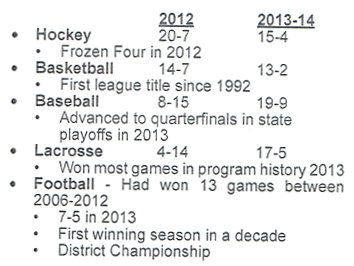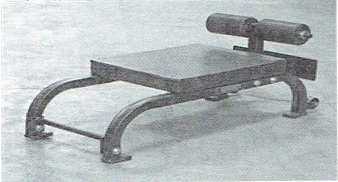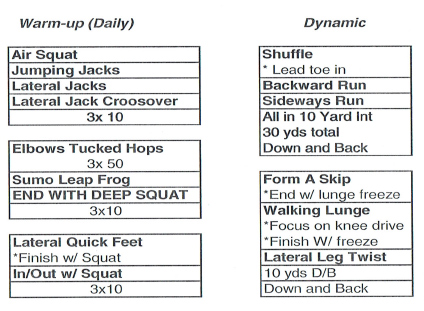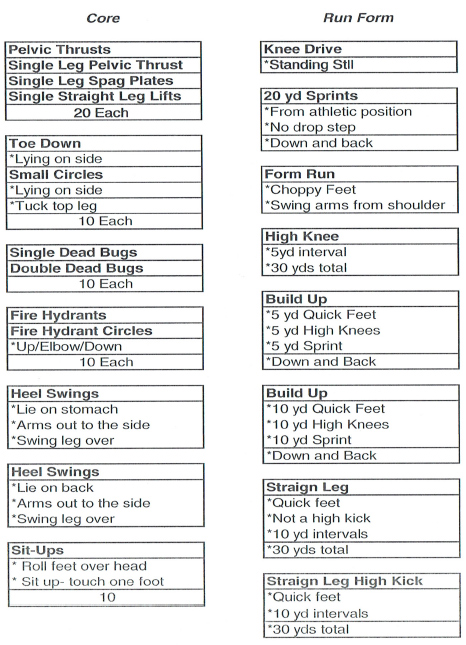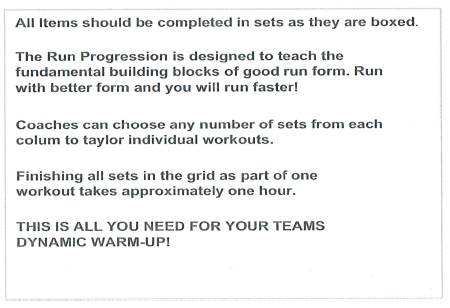|
A Model Strength and Conditioning Program By: Nick Kocsis and Ralph Neal Originally Published in: Nike 2014 Coach of the Year Clinics Clinic Notes - by Earl Browning
Nick Kocsis: Athletic Director - University of Detroit Jesuit High School. Detroit. Michigan I am not a coach anymore. I am a nerdy history teacher. I played football my whole life. It was my passion. Now weight training and fitness is my passion. Three years ago. I left my best friends and took an athletic director's job in Detroit. I was an assistant football coach and head track coach at Zeeland East High School with these guys who are here today. I do not get to coach football anymore. So. by hook or by crook. this is what I get to do for my athletic program. I am going to give you everything I have. I am happy to be here. I want to go ahead and start. First, I would like to thank Coach Derek Pennington. He is the head football coach at Zeeland. I have had the opportunity to go all over the country giving the same presentation we are giving here today. We went to Nike Clinics in California, Las Vegas, Denver. and now Louisville. It has been an honor. The reason we get to do this is because we believe in something. Coach Pennington talks about winning collisions all the time. Football is like a bar fight. There are two things I want to say about a bar fight. If you can win a bar fight, you probably can win a football game. The second thought is "speed kills." I am the athletic director at U of D Jesuit High School in Detroit, Michigan. We are not a football factory. If you coach several 285-pound monsters that run 4.6, you do not need to be here. You could be at home right now. Most of us are coaching in small towns. Most of us have bitter rivalries across our parking lots. We have to take the players we have in our school and make them better. You have to find a way to win. What Coach Pennington has done at Zeeland is amass a 47-14 record with a couple of undefeated seasons. If I told you coaches in here that you could have 47 wins over a six-year period, a bunch of you would take that. The school I went to in Detroit had not had a winning football season in a decade. This year we went 7-5 and won a district championship against a good football team. Max Prep rated the conference in which we play as the fifth most difficult conference in America. We are the Northwestern or Vanderbilt type of school in our league. We do not get the players that go to St. Ignatius and St. Xavier. The big players end up at the football schools. We have to take the players we have and make them better. A quote, which came from the movie Money Ball expresses how I feel. It said, "I hate losing more than I love winning." How do we take the players we have and make them better? We have to make them faster and stronger. We have two programs here that can help. I am going to talk about the organization. You can duplicate this in your school and begin to believe as we believe. The beautiful thing about what we do is you can tailor it to fit what you do. It is a philosophy and the summer is an important part of that. We all work in the summer time. How many coaches sat in the weight room all day hoping some players would show up to lift. We have all done it. We do that because we feel we owe it to them. You are in the weight room and some of them come but most do not. You are angry and the players do not buy into what you are trying to do. You do not get the fellowship that is so important in a program. How do you make this work? We have found a way. Here is the long story told short. In Zeeland about seven years ago, we had one school split into two schools. It caused many issues about the haves and have noes that now exists in the two schools. One of the athletic directors went to the booster club and tried to talk them into giving money to the players to hire a private strength trainer. It was like what happens on the street corner. Everyone had his hand out and everyone wanted our player's money. All you want to do is see your players in the summer time. You want your players to believe in what you believe in and work next to their brothers. You want them to have common suffering and become a team. What is happening is Mom and Dad are taking their money and blowing it on a strength or a speed coach. You are not coaching your players. We did not want the parents to take their money and give it to some outside person to train our players. That is where this idea was born. Most programs do not have a strength coach. The head coach is the strength coach. I am the athletic director at my school. I do not coach anything. Therefore, I became the strength coach in my school. I have been in football for a long time but being the strength coach is not my trade. I provide a comprehensive, organized, low cost, alternative, that your players cannot say no to. • Summer Program Last 6-7 Weeks In Zeeland, we created a program and gave it a name. We called it the "EDGE." It lasted six or seven week depending on the summer time. Some school districts have longer summers than others. It depends on the school calendar. We work on Monday, Tuesday. and Thursday. Fridays never seem to work out when you work with teenagers. That is the first thing you do. Do not plan anything on Friday. Do not give the players a reason not to come. We charged the players 50 dollars for 18-20 workouts. That was three dollars a workout. We have bumped it up to 75 dollars for the entire summer. When parents pay anything for their kids to workout, those kids are going to work out because they paid for it. That is the psychology behind it. When you pay something toward a program, it automatically legitimizes it. People think if it costs something it must be better. That is what the street agents are doing. They tell the players and parents they are a speed coach and for $450, they can get you to 4.5 in the forty. At the end of the program, the player runs a 5.0 but the guy holding the stop watch said it was 4.5. That is the same guy you just gave $450. Do you want that guy coaching your players or do you want to coach them? THE ANSWERS • Most of us are already providing the answer You must create a valuable program. It can generate income for your program. You can make it just for the football program or open it up to all sports. Football is my first love, but being an athletic director. I have to do what is good for the entire athletic program. That pays dividends because in most small schools, the athletes must cross over to other sports. In football, you want your wide receivers to be basketball players. The best running back is a track star. Coaches in other sports were reluctant to commit to this type of program. The football coaches wanted to control the program and make it for football playing skills. At our school, the football program is the driver for all the other sports. Football coaches begged the other coaches to come and join them in the program. They told the other coaches they would work their athletes and make them better in their sport. When I came into this situation, I installed the program, put my head down and went to work. Everyone looked at what was going on and wanted to be a part of it. In this program, there is no specialization. Everyone does the same thing. We talk about training movements and not muscles. We train movement and explosion as part of our weight room. The athletes must be faster and stronger today to compete. I was the head track coach at Zeeland and we won the first regional championship while I was there. Coach Neal coached state champions in the shot-putt and discus throw. We both did the same workouts in the same program. Speed and strength came from the same program. On the football field, speed kills. There are two ways to get faster. If you get stronger, you can put more force on the ground and push harder off the ground and you go faster. The second way to get faster is to improve your technique. We developed a speed school. We do not static stretch at all. The only time we do a static stretch is before a football game. And then. it is more tradition than stretching. Can you control how hard a player stretches? If you spend 10-15 minutes in a static stretching drill before practice. how many plays can you run in 15 minutes? The object of stretching is to get warm. If you do static stretching, it is like taking a rubber band and pulling it out. You are turning the muscle into a piece of silly-putty. in the warm up. all you want to do is get blood to the muscle. You get blood in the muscle by running. I am not telling you to run 100-meter dashes. We brought all our run progression material with us today. I brought the menu and you are welcome to have it. By doing the progression, you will get stronger. faster. and have better technique. We use the warm up to teach run form. The Run Progression Form is at the end of the lecture. WHAT ABOUT THE REVENUE? Revenue pays for... When you start this program, make sure you pay your coaches because their time is valuable. Have T-shirts as part of the reward system. Players will do anything for a T-shirt. Create a brand, an image, and something to be proud of doing. If you collect $65 a player, T-shirts are four dollars apiece. Before you know it, you will have all the kids in town wearing an advertisement of your program. SUMMER DAYS • Every day we work to get stronger, faster, and more agile I am going to show you how we organize the program, but it does not have to be done the way we do it. SUMMER SCHEDULE Zeeland East We work Monday, Tuesday, and Thursday mornings. The varsity and JV football players come from 7-9. We work an hour of speed training and an hour of weight room. We wanted to take our older players first. You want to take care of your older players because they are the ones that will be playing the games. They work on their speed training and conditioning first and go to the weight room second. We take them in the speed training while they are neurologically fresh. The younger players go to the weight room first. After an hour, you switch. The older players go to the weight room and the younger players go for speed training. From 9:00-10:30, we have the seventh, eighth, and ninth grader come in for their training. It is a coed group and we give them a watered down version. We had a separate session for the women. They do the same thing as the men, but the numbers were so good, it worked out better that way. U of D Jesuit At my school, players come from all over the metro to train. Seven o'clock did not seem to work for us so we went from 8-10. I have all the varsity athletes show up at 8:00. I take the football players, which are varsity, JV, and freshmen, to speed training first. That group is 75-80 players. The other varsity sports go to weight training first. After an hour, we switch, It is the same idea as before with giving the priority to the group that is more important. We do the outside speed training with a certified speed coach. We are not just running gasser all summer long. We are teaching explosion and acceleration, as well as running form. YOUNG ATHLETES Grades 7, 8 & 9? At 10:00 am the younger players come in and do their training. We do the exact same stuff but we water it down a little. With the younger players, you have to make it fun. You cannot beat players up and run them off. You need some fun stuff and competitions. You have to teach them the proper techniques of lifting free weights. The ninth graders get two days in the weight room and the seventh and eighth graders get one day in the weight room. If the numbers are right, I can group the ninth and eighth graders together and give them two days in the weight room. We work three days a week with the older players and two days a week with the younger players. With the younger players that work a shorter time schedule. we do not switch their workouts. WHY MORNING WORKOUTS? • No other activities at 7:00 AM At 7:00 in the morning, there are no AAU basketball practices. no jobs, and no baseball. It is easier for a player to change his schedule than it is for you to change yours. Do not give your players a choice of working in the morning or at night. That will create dissention among the groups. Tell them this is when we work out and they can adjust their schedules to yours. We go to work at 7:00 in the morning and are done by 9:00. They can be to work at 9:15. WHAT TO EXPECT • It will never work here! If you try to do this type of program, the first thing you will hear is, "It will never work here!" They want to know why players would pay to do this. Zeeland is a small town and a beautiful community. When this program is going on there are 100 bikes outside the stadium every day. Parents drop them off or they ride their bikes. That is completely different then where I am now. We are the last catholic high school in the city of Detroit. Within the area, there were five catholic all-boys high schools. They all cut and ran to the suburbs. We play in that league. We have a beautiful building but the kids come from severely depressed areas. They do not ride their bikes to our field. We raised money and renovated our weight room. We threw out all the junk and opened up the room. I had seven military press racks. I got rid of them. Space is what you need in a weight room. You need space. You are better off throwing out all the machines and things that are no longer current. You are better off having a few machines and space to work, than the flavor of the month machine. DON'T LISTEN TO THE NAYSAYERS • Summer of 2012 When we started the program in 2012, I was hoping for a 100 kids. If I could get my football coach to buy into the program, that would be 100 players in the program. The first day we had 270 kids. They are not there every day, but we average 240 kids a day. Last year we had 286. In our school, the sports teams are a total buy-in to the program. Football, basketball, hockey, and lacrosse are all on board with the program. SUSTAINABLE SUCCESS IS A PRODUCT OF THE PROCESS
I know I have used some of Ralph Neal 's time, so I want to turn it over to him. RALPH NEAL: Zeeland East High School, Michigan As Nick said. my background is in track and field and the weight room. They got me involved with football but my true passion is the weight room and track and field, in particular the throws. I came from a very successful program that is known for Olympic type lifts. Not only do we work on the Cleans and Snatches but other Olympic lifts. Before Coach Pennington showed up seven years ago, our football program was terrible. I think the entire time I was there we won seven games in a six-year run. The first time I ever met him, he came into the weight room. I was working with three or four of his big players. We were doing some Olympic lifts. He told me the weight program was excellent but the football program sucks. He told me he wanted his entire football team doing Olympic lifts in the weight room program. He came in and completely revamped the weight room and designed a process to make it work. What you are going to see in the next 30 minutes is how we teach kids starting with the seventh grade and coming all the way up to the high school. how to do Olympic lifts. HOW TO MAXIMIZE TIME IN THE WEIGHT ROOM! Everyone: • Learns the same progression model (7th/8th) INCORPORATE SUPER SETS!!! Any time we get ready to do any type of jumping or Olympic lift, we recite the rules for lifting. • Head up I find teaching players with dumbbells initially, is far more productive and easier than using the bar. I do not have any fancy letters after my name. What I do comes from the experiences I have had. The first thing is the one-arm dumbbell snatch, which will eventually lead into a huge list of exercises I will show you in a second. In this exercise, we start out with the rules. Head up, chest out. and weight on the heels. We talk about reading their t-shirt in the mirror. Self-coaching is a big thing because I am one coach with 30 or 40 players. I tell them if they can see their t-shirt in the mirror, they know they are doing the exercise correctly. If they cannot see their t-shirt, that means their head is not up and their chest is not out. When you do Olympic lifting, strength, timing, and balance are all part of the lift. The dumbbell clean and jerk and snatch have similar techniques. When you first start to pull the weight off the floor, most of the work is done with the legs, which are driving upward. Once the legs fully extend, the weight has probably come up to the chest. At that point, you squat down quickly, flip the forearm as your body goes under the weight, and shrug your shoulders. You come back to the standing position. The weight is in the clean position at the top of the chest. If we continue with the jerk portion of the lift, we jump the weight with a parallel jump and not a split jump. It is important to incorporate a jump into the exercise. It gives you an extra bit of power. The "stomp" down help you drive up with more power. We want the jump with the feet slightly wider than the shoulders and in a parallel position. That lends to balance. • Jump, jump, pull (drive elbow to roof) When you work with the dumbbell cleans make sure you work both sides equally. We want to think JUMP at all times. The jump is the pounding of the floor with the feet as you jerk the weight over your head. The elbow locks during the jump phase. Reversing the movement will help maintain proper technique. To get into the snatch position, you start the same way. The difference is when you drop beneath the weight, the arm keeps extending into a locked out position above the head. When you do this, you want the dumbbell handle parallel to the body. • Jump, jump, pull (drive elbow to roof) We work on an explosive movement from the floor to the chest. We want the correct muscles moving the weight. That is the reason for the squat position. It puts the legs and back into the lift instead of simply the shoulders and arms. We want to get the negative part of the lift when returning the weights back to the floor. That gives us more bang for our buck. We want to do the reverse movement from the top to the bottom, when the weight comes down. • DB Jumps and Pulls are same as the snatch We perform Olympic exercises on a weekly basis. You will not see all the exercises on the list in the same workout. We do bits and pieces on specific days. We can do most of the exercises with a bar or a dumbbell. It is the choice of the player as to which method he wants to use. • High Pull I want to talk about the facility and equipment that goes with the weight room. Sometimes the cost of equipment can hamstring a program. If I have a limitless budget, I would have a huge weight room with 12-15 racks and endless sets of weights and dumbbells. If you have a weight room with a full set of dumbbells that is a great starting point. I do not need all these great special racks. If you give me dumbbells, I can do 90-percent of what we need to do for our players to be more explosive. We do high pulls, which brings the weight from the floor to the chest area. The next exercise is the high pull with the snatch. They bring the weight from the floor and snap it over the head in one movement. We do high clean movements. which is an upright clean. Some people say it is a power clean. We also do the deep clean. As the weight comes up to the clean position, the players squat under the bar into a deep squat position before standing up. The deep clean tells me how athletic the player is. If you find a player that can do the deep cleans and make it look smooth and effortless. you have an athlete on your hands. You will find big strong linemen, that benches and lifts heavy weights, that cannot get into a deep clean position. It takes great flexibility as well as strength. We place emphasis on the jump stance with the feet underneath the shoulders. The squat stance is slightly wider than the shoulders. We do clean combos in our exercises. The player cleans the weight and presses it over his head. He can press in front of his head and behind the neck. I tend not to do behind the neck presses with the younger players. It can be dangerous if they lose control of the weight. It takes more strength and agility to do that type of exercise. We want to do exercises that keep the bar moving. We use Dynamax balls in our squat exercise. When we squat the weight, if the rear end does not hit the ball, they have not gone far enough. The only true purpose of that ball is to make sure the players know they are getting deep enough in their squat position. When you here coaches talk about their players squatting 600 pounds, that is a one foot squat. They are not getting anywhere close to low enough where the thighs are parallel to the ground. We found when we use the ball the players do not cheat as much because that is the standard for a repetition. Some of the taller players complain that they have so much further to go to hit the ball. My response to them is, it is not a weight lifting contest. We are working on individual improvement. If they go from 200-pounds to 240-pounds. that is what we are looking to do. We are trying to get improvement in strength and explosiveness. Our best football player is not the strongest player in the weight room. The strongest player did not start. This training is not a direct correlation of how good of a football player the athlete will be. What I am working for is to bring everyone up in his level of strength. AUXILIARY LEG EXERCISES • Goblet Squat We do a number of exercises that work on the legs. The Goblet squat is not loading the spine of a young player. Anything that is a body weight movement is fine for young players. The Goblet squat is a squat holding the dumbbell in front of them. It is a deep knee bend with the butt going as close to the ground as they can get it. I call it taking a dump. This is a warm up movement to start to loosen up the posterior chain of muscles. When we put the dumbbells in their hands, they must get as low as they can. We want them to get at least to a parallel bend in the legs. I want to see the hips well below parallel. The weight is in front of them and if it gets too heavy for them, the weight dumps forward. We do box jumps. One of the first purchases that Coach Pennington made when he came in was foam plyo-boxes. No longer do players have to worry about scaring up their shins. Now they can challenge themselves without the fear of busting up a knee or shin. The side lunge is something we do at the beginning and end. It is a stretching type exercise with the leg extended to the side and moving the butt down to the ground. That way they can stretch before lifting and it is better than just bending and touching their toes. CORE UPPER BODY EXERCISES • Bench Press I assume that everyone in here is familiar with these exercises. Do not waste space in your weight room with a dip machine. I must work 40 players through this work out in one hour. We do not have time to wait to use a dip machine, when you can work multiple numbers of players on dips on any number of stations. Think of ways to use the equipment you have to do these exercises. AUXILIARY UPPER BODY EXERCISES • Flat DB Bench I have 10 squat racks in my room. We do not use stats cards. I do not have players walking about the room filling out cards and sheets of paper about their workout. The players must know three things. They must know their bench max. squat max, and pre max. I have percentage cards posted all over the weight room. They can find in a second what 60-percent of their bench max is. We do a set every one to two minutes. In the room, I have a huge white board with their entire workout and exercises for that day. After the warm up and cool down, I am able to get through 30-40 sets of exercise in 35 minutes. We have stolen time from other exercises that we do not do any more and added to the time in the room. They weight room is like the football field. We play with an up-tempo situation. HERE IS HOW WE DO IT. • Weight room Structure EXAMPLE SUPER SET COMBINATIONS • HPS (High Pull Snatch) 6 X 2 (45/sec) I can get through six sets of the HPS in 4 minutes and 30 seconds. After that, there is a one-minute break. During that time they get ready for their squats and one arm rowing. Football is changing with the tempos. I think the way we work in the weight room adds to their preparation for football and builds their stamina and endurance. We work in groups of 3-4 players. The first player does his HPS. which takes 45 seconds. He goes to the box jumps next. He does his box jumps and is back up for the second set of HPS in 45 seconds. On the wall, I have a segment timer, which I can set to beep at any time interval I chose. The players know as soon as the beep goes off they end their set and go to the next exercise. We get a ton of work done in a short amount of time. If you are into power lifting, this regiment will get you about 90-percent of where you want to be. If your goal is to squat 500-pounds, this workout is not ideal for you. It is not long enough. That is not what this program is all about. I want to know how hard the players can go in the fourth quarter. We sacrifice a little on the strength component to build the fitness part of the player. If you watch our game film, we go hard in the third and fourth quarters. I know we went long at the beginning but all this material is on video. I will leave you with two examples of our Monday and Friday workouts. EXAMPLE MONDAY WORK OUT • HPS 3 X 3 EXAMPLE FRIDAY WORKOUT • Clean Combo-(1+2+1)by 3 © 60% I appreciate your attention. If I can help, you please contact us and we can make what we know available. Thank you for your time. University of Detroit Jesuit Run Progression
|




